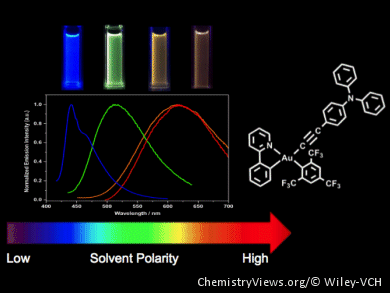Gold(III) complexes that display intense luminescence at room temperature both in solution and in solid state are uncommon. Koushik Venkatesan, Institute of Inorganic Chemistry, University of Zurich, Switzerland, and his group have found that through a judicous choice of ligands they have been able to prepare novel monocyclometalated gold(III) monoaryl complexes that display phosphorescence emission at room temperature in solution and in the solid state.
The emission wavelength energies were highly tunable, depending on the cyclometalating ligand and replacement of the chloride ligand with electronically different ligands, such as cyanide and alkynes, thus allowing good quantum efficiencies to be achieved. The quantum efficiencies achieved in the solid state and solution at the red and deep-blue region, respectively, are among the highest for monocylometalated gold(III) complexes reported until now.
The good luminescence efficiencies combined with widely tunable emission behavior and thermal stability of these complexes make them a promising fragment for the synthesis of highly efficient triplet phosphors for OLEDs applications.
- Monocyclometalated Gold(III) Monoaryl Complexes—A New Class of Triplet Phosphors with Highly Tunable and Efficient Emission Properties,
A. Szentkuti, M. Bachmann, J. A. Garg, O. Blacque, K. Venkatesan,
Chem. Eur. J. 2014.
DOI: 10.1002/chem.201303673




